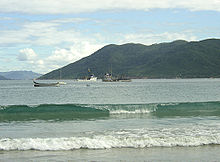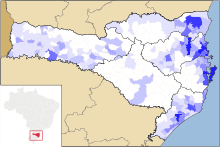Santa Catarina
| Estado de Santa Catarina | |||
|---|---|---|---|
| Symbols | |||
|
|||
| Basic data | |||
| Country | Brazil | ||
| Capital | Florianópolis | ||
| surface | 95,738 km² | ||
| Residents | 6,248,436 (2010) | ||
| density | 65 inhabitants per km² | ||
| ISO 3166-2 | BR-SC | ||
| politics | |||
| governor | Carlos Moisés da Silva (since April 5, 2018) | ||
| Political party | Movimento Democrático Brasileiro (MDB) | ||
Coordinates: 27 ° 16 ′ S , 50 ° 29 ′ W

Santa Catarina (German "Sankt Katharina", officially Portuguese Estado de Santa Catarina ) is a federal state in southern Brazil . There are a significant number of people of German origin in Santa Catarina . Blumenau is famous for its half-timbered houses and its Oktoberfest . Other cities such as the capital Florianópolis , the port city of Itajaí , the small town of Pomerode and the textile industry have made Santa Catarina famous. Some places with German names were Portuguese , such as Treze Tílias ( Dreizehnlinden ), the "Brazilian Tyrol".
geography
The area is only about 95,738 km² (2017), the population was 6,248,436 according to the 2010 census. The number was estimated by the IBGE on July 1, 2019 to rise to 7,164,788 residents. The population density is 65 people per km². This makes Santa Catarina one of the smaller states in Brazil , it ranks 11th out of 27 comparable administrative levels.
The state borders Argentina with a short border to the west . Santa Catarina is bounded by the Atlantic Ocean to the east, the Brazilian state of Rio Grande do Sul to the south and Paraná to the north .
The capital is Florianópolis , other well-known cities are Joinville and Blumenau .
In terms of landscape, the state is divided into eight regions.
History and culture
Colonial times and "Republic of Juliana"
Already at the beginning of the 16th century, references to Santa Catarina were mentioned in various records by Spanish seafarers. What is certain is that in 1515 a ship belonging to the explorer Juan Díaz de Solís was shipwrecked on the coast of the state, which can be seen as the beginning of colonization by the Spaniards. Later the Portuguese came to Santa Catarina, especially emigrants from the Azores . In the 19th century there was an increase in the immigration of Italians, Poles, Russians, Belgians and Germans.
To this day, these groups shape the culture of Santa Catarina and give this state a special, European charm. Known also beyond the borders of Brazil is u. a. the year in Blumenau held Oktoberfest Blumenau .
From 1822 to 1889 it was the province of Santa Catarina in the Brazilian Empire . In 1839 the Farrapen Revolution expanded to Santa Catarina, where the short-lived Juliana Republic was proclaimed.
Settlement by emigrants
Population development
| year | population |
|---|---|
| 1960 census | 2,146,909 |
| 1970 census | 2,930,411 |
| 1980 census | 3,687,652 |
| 1991 census | 4,538,248 |
| 2000 census | 5,349,580 |
| 2010 census | 6.248.436 |
| 2019 estimate | 7,164,788 |
politics
Santa Catarina's first constitution dates from 1891, the last version was adopted in 1989. The executive power is exercised by a governor . In the 2010 gubernatorial elections in Santa Catarina, the candidate Raimundo Colombo , who ran for the conservative-business-liberal Democrats , received 52.72% of the vote. In 2011 he switched to the Partido Social Democrático (PSD). Colombo was re-elected in Brazil's 2014 gubernatorial elections, but resigned on April 5, 2018, pending a Senate post. The successor and acting governor has been his former lieutenant governor Eduardo Pinho Moreira of the Movimento Democrático Brasileiro (MDB) from April 2018 until the elections in Brazil in 2018 .
In the unicameral system in Santa Catarina, the legislature is in the hands of the Legislative Assembly of Santa Catarina or Assembly of Representatives ( Assembleia Legislativa do Estado de Santa Catarina , ALESC), which consists of 40 parliamentarians. The legislative period lasts four years. Julio Garcia ( PSD ) is president of this state parliament for the first biennial term .
In the 56th legislative period from February 1, 2019, the federal state will be represented in the Federal Senate of Brazil by three senators: Dário Berger ( MDB ), Esperidião Amin ( PP ) and Jorginho Mello ( PL ). 16 MPs represent the state in the Brazilian Chamber of Deputies .
Cities
The total number of cities in Santa Catarina with the status of a Município (also municipal city , city with the right to self-government) is 295. Many of these are grouped together in one of the ten metropolitan regions : Carbonífera , Chapecó , Contestado , Extremo Oeste , Florianópolis , Foz do Rio Itajaí , Lages , Norte / Nordeste Catarinense , Tubarão and Vale do Itajaí .
![]() Map with all coordinates of the cities section : OSM
Map with all coordinates of the cities section : OSM
The ten largest cities in the ranking of the last 2010 census are:
| rank | local community | Population 2000 census |
Population census 2010 |
2018 estimate |
|
|---|---|---|---|---|---|

|
1 |
Joinville |
429,604 | 515.288 | 583.144 |

|
2 |
Florianópolis |
342,315 | 421.240 | 492,977 |

|
3 |
Blumenau |
261,808 | 309.011 | 352,460 |

|
4th |
São José |
173,559 | 209,804 | 242,927 |

|
5 |
Criciúma |
170.420 | 192.308 | 213.023 |

|
6th |
Chapecó |
146.967 | 183,530 | 216,654 |
|
|
7th |
Itajaí |
147.494 | 183.373 | 215,895 |

|
8th |
Jaraguá do Sul |
108,489 | 143.123 | 174.158 |

|
9 |
Lages |
157,682 | 156,727 | 157,743 |

|
10 |
Palhoça |
102,742 | 137,334 | 168,259 |
Source: IBGE
Former geostatistical classification
Santa Catarina was divided into six geostatistical mesoregions by the Instituto Brasileiro de Geografia e Estatística (IBGE) from 1989 to 2017 : Grande Florianópolis , Norte Catarinense , Oeste Catarinense , Serrana , Sul Catarinense and Vale do Itajaí .
These were in turn divided into a total of 20 micro- regions: Araranguá , Blumenau , Canoinhas , Campos de Lages , Chapecó , Concórdia , Criciúma , Curitibanos , Florianópolis , Itajaí , Ituporanga , Joaçaba , Joinville , Rio do Sul , São Bento do Sul , São Miguel do Oeste , Tabuleiro , Tijucas , Tubarão and Xanxerê .
Industry and agriculture
The most important economic sectors in Santa Catarina are the metalworking and electrical industries around Joinville and Jaraguá do Sul , the textile and glass industries around Blumenau, Brusque and Rio do Sul, the wood processing industries around Rio Negrinho , São Bento do Sul and Porto União , mining of minerals, fishing and livestock, as well as tourism.
literature
- Walter Piazza : Santa Catarina, sua história . Universidade Federal de Santa Catarina, Florianópolis 1983.
Web links
- Santa Catarina Government (Brazilian Portuguese)
- Assembleia Legislativa do Estado de Santa Catarina website (Brazilian Portuguese)
- Interactive map
Individual evidence
- ↑ a b Instituto Brasileiro de Geografia e Estatística (IBGE): Estados @ Santa Catarina - Panorama . Retrieved September 5, 2019 (Brazilian Portuguese).
- ↑ Arrival of the German and Italian ( Memento of the original from August 29, 2014 in the Internet Archive ) Info: The archive link was inserted automatically and has not yet been checked. Please check the original and archive link according to the instructions and then remove this notice.
- ↑ http://www.hart-brasilientexte.de/2011/10/12/brasiliens-joinville-stadt-im-deutsch-gepragten-sud-teilstaat-santa-catarina-lebensstandard-soziokulturelles- level- weit-uber- dem - national average-photo series /
- ↑ a b Instituto Brasileiro de Geografia e Estatística (IBGE): Estimativas da população residente no Brasil e unidades da federação com data de referência em 1 ° de julho de 2018. (PDF; 2.6 MB) In: ibge.gov.br . 2018, accessed October 3, 2018 (Brazilian Portuguese).
- ^ David X. Noack: Garibaldi's fight for the Republic of Rio Grande do Sul amerika21.de, September 22, 2012.
- ↑ Brazil: States and Major Cities - Population Statistics, Maps, Charts, Weather, and Web Information. Retrieved December 22, 2017 .
- ↑ Results of the 2010 elections . Retrieved August 15, 2015 (Portuguese).
- ↑ Colombo entrega carta de renúncia na Alesc para disputar eleições . In: G1 . April 5, 2018 (Brazilian Portuguese, globo.com [accessed October 3, 2018]).
- ↑ Todos Deputados , site ALESC. Retrieved April 26, 2017 (Brazilian Portuguese).






